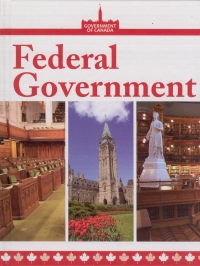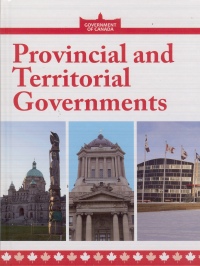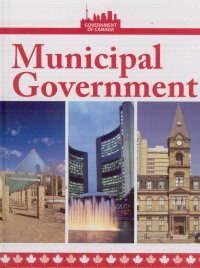| ________________
CM . . . . Volume XVII Number 30 . . . . April 8, 2011

 |
Federal Government. (Government of Canada).
Heather C. Hudak, ed.
Calgary, AB: Weigl, 2011.
32 pp., pbk. & hc., $12.95 (pbk.), $24.95 (hc.).
ISBN 978-1-55388-681-5 (pbk.),
ISBN 978-1-55388-677-8 (hc.).
Grades 6-8 / Ages 11-13.
Review by Harriet Zaidman.
* /4
|
| |
|
 |
Provincial and Territorial Governments. (Government of Canada).
Anita Yasuda.
Calgary, AB: Weigl, 2011.
32 pp., pbk. & hc., $12.95 (pbk.), $24.95 (hc.).
ISBN 978-1-55388-682-2 (pbk.),
ISBN 978-1-55388-678-5 (hc.).
Grades 6-8 / Ages 11-13.
Review by Harriet Zaidman.
* /4
|
| |
|
 |
Municipal Government. (Government of Canada).
Steve Goldsworthy.
Calgary, AB: Weigl, 2011.
32 pp., pbk. & hc., $12.95 (pbk.), $24.95 (hc.).
ISBN 978-1-55388-683-9 (pbk.),
ISBN 978-1-55388-679-2 (hc.).
Grades 6-8 / Ages 11-13.
Review by Harriet Zaidman.
* /4
|
| |
|

excerpt:
Each legislature is made up of elected members. Elections must be held at least once every five years. The time between these elections may be shorter, though, if the premier calls for an election sooner. (From Provincial and Territorial Governments.)
The above statement is incorrect. The majority of Canadian provinces now have fixed-term elections – a predetermined date on which general elections are held, as in the American system. The federal government also enacted similar legislation, but has, as of 2010, ignored it once.
The names of the provinces that have adopted fixed-term limits and the dates their legislation was passed was found through an Internet search, then verified several times more through further searching.
Information on the different levels of government in Canada is widely available to nonfiction writers through books and educational and government websites. It's also widely discussed through the media on a continual basis, and one would expect that writers on these topics should at least pay attention to current events. Publishers who want libraries and teachers to purchase their materials should produce books with accurate, precisely-written content. It's a simple business decision.
Here are a few examples of why teachers and libraries should not buy the three books in this series:
- In Provincial and Territorial Governments, the logos of the federal political parties are displayed on page 13. However, a quick Internet search shows that the logos for the provincial parties are different from their federal counterparts. Those logos are not shown. The federal logos are not displayed in the descriptions of the parties in Federal Government.
- In Federal Government, commonly recognized terms, such as 'Official Opposition', are not capitalized. The Government of Canada website treats these terms as proper nouns.
- The federal legislative body is commonly known as Parliament in Canada, but a heading on page 16 in Federal Government, reads 'Passing Bills in the Legislature' – sure to confuse any student who knows that provincial government bodies are commonly knows as legislatures.
- The same page shows a picture of five people sitting at a curved desk, each with a microphone. One woman is talking. The caption reads: "Passing legislation starts with the proposal, formulation, and drafting of a bill." Since this book is about the federal government, and the artwork at the top of the page shows the Houses of Parliament, one wonders why a picture of the inside of Parliament is not included. An Internet search of images of all the legislative bodies in Canada (including the territories) seems to show that the image on page 16 is a generic picture of people talking. If it's a committee of Parliament, neither the location nor names of any Members of Parliament are identified.
- On page 16 of Municipal Government, the title 'The Power of By-laws' discusses the work of civic councils. A picture with the caption "Citizens may organize demonstration to show support or opposition to particular by-laws" shows people holding placards reading: 'Keep Hydro Public – Don't Sell Out'. The placards are sponsored by the Power Workers' Union. For those who are unaware, the Power Workers' Union represents Ontario Hydro workers, and Hydro is a provincial responsibility in Ontario, not municipal. This picture does not belong in Municipal Government.
- Page 17 of the same book has a subtitle 'Some Interesting By-laws', which includes a bylaw- from Kitchener, Waterloo that requires citizens to clear their sidewalks within 24 hours of a snowfall. There is no explanation as to why Kitchener's by-law is 'interesting' or unique. A search of the City of Toronto by-laws informs one that residents have only 12 hours to clean their sidewalks. Winnipeg has no such by-law. Which of these is more 'interesting'? There are other examples under this subtitle, including 'no one can make noise that disturbs the peace" in Vancouver. This is not an uncommon by-law.
- In describing the operation of cities, Municipal Government has a chapter entitled 'City Hall: The Calgary Model'. The description of Calgary's civic administration is fairly mundane; nowhere is it indicated that Calgary has developed a model after which other cities model their operations. A picture and caption on the same page only talk about how often the clock on the historic city hall is wound.
There are also wasted pages at the end of each book where the reader is asked – 'What Have You Learned?" – when more content could be included. Another page encourages the reader to look for other sources (in this case a good idea). Page 28 of Federal Government suggests an activity about animals sharing their opinions and voting to resolve an issue. It's inappropriate and childish for a book targeted for ages 11-13, and it is out of sync with anything else found in the three books reviewed here.
Teachers are looking for reliable materials to counter the problems that unverified searches and unreliable sites on the Internet produce. Unfortunately, the "Government of Canada" series is fraught with errors. It shows a lack of editorial planning, rigour and oversight. Students doing research would not be properly educated about a topic important to their development as citizens. This information is readily available, and authors such as Linda Granfield (Canada Votes: How We Elect Our Government) have produced excellent books for young researchers.
The examples above and many more disqualify the "Government of Canada" series as a useful purchase.
Not recommended.
Harriet Zaidman is a teacher-librarian in Winnipeg, MB.

To comment
on this title or this review, send mail to cm@umanitoba.ca.
Copyright © the Manitoba Library Association. Reproduction for personal
use is permitted only if this copyright notice is maintained. Any
other reproduction is prohibited without permission.
NEXT REVIEW |
TABLE OF CONTENTS FOR THIS ISSUE
- April 8, 2011.
AUTHORS |
TITLES |
MEDIA REVIEWS |
PROFILES |
BACK ISSUES |
SEARCH |
CMARCHIVE |
HOME |


